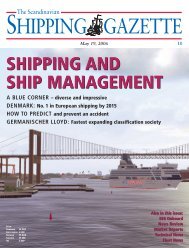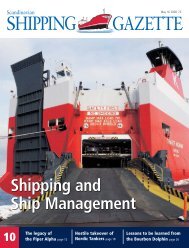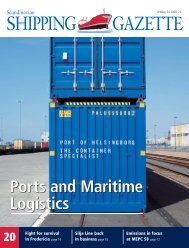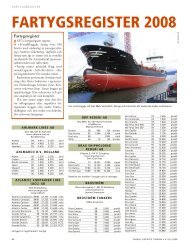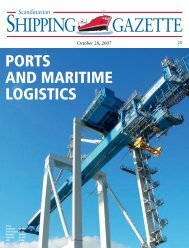SSG No 10 - Shipgaz
SSG No 10 - Shipgaz
SSG No 10 - Shipgaz
You also want an ePaper? Increase the reach of your titles
YUMPU automatically turns print PDFs into web optimized ePapers that Google loves.
The Tenna Kosan owned by Lauritzen Kosan, 4,000 cbm LPG carrier.<br />
Nearly 80 Liquefied Petroleum<br />
Gas (LPG) carrier owners<br />
worldwide are grappling<br />
with deteriorating market<br />
conditions and lower export<br />
volumes. Only 23 per cent of the total<br />
LPG production is shipped by sea, and<br />
this seaborne trade is forecast to grow to<br />
68 million tonnes by 20<strong>10</strong> and to as much<br />
as 98 million tonnes by 2015. However,<br />
since Ocean Shipping Consultants (OSC)<br />
made this forecast in 2005, the growth in<br />
demand for LPG products has slowed. One<br />
might have assumed that retail consumers,<br />
environmentally conscious as they should<br />
be, would switch more to LPG from other<br />
fuels, but that has not been the case.<br />
According to Poten & Partners, well<br />
known for its LPG reporting and forecasts,<br />
LPG trading started this year on a sombre<br />
LPG: Substantial<br />
carrier scrapping<br />
necessary<br />
An orderbook of 47<br />
per cent of the existing fleet<br />
should be the writing<br />
on the wall for any owner.<br />
note, even though LPG freight remained<br />
at very depressed levels and butane and<br />
propane prices are as usual following the<br />
oil prices. Owners are also faced with a<br />
total orderbook of 7.3 million cubic metres<br />
(cbm), or some 47 per cent of the existing<br />
fleet. The orderbook is dominated by the<br />
80,000 cbm capacity or bigger and most of<br />
the deliveries are due in 2008 and 2009.<br />
An orderbook of 47 per cent of the existing<br />
fleet should be the writing on the wall for<br />
any owner and large scale scrapping will be<br />
necessary. The biggest current segment, the<br />
70,000–79,000 cbm, has a total of 83 units<br />
with an average age of only 15.8 years, but<br />
with a total capacity of 6.3 million cbm.<br />
The biggest owner of LPG tonnage is<br />
BW Gas with 1.89 million cbm of capacity.<br />
BW Gas is totally dominant in the Very<br />
Large Gas Carrier (VLGC) segment, but<br />
15 of the big vessels are between 20 and<br />
30 years old. Ranged behind BW Gas are<br />
Naftomar Shipping, Mitsui OSK Lines,<br />
Yuyo Shipping, Sanko Steamship, Solvang,<br />
Kawasaki Kisen Kaisha, Kuwait Petroleum<br />
and CMB. The older vessels are likely to<br />
be scrapped in the next two to three years.<br />
Scrapping policies and vetting<br />
As with most other types of tonnage, different<br />
owners adopt different scrapping<br />
16 THE SCANDINAVIAN SHIPPING GAZETTE • MAY 21 2007<br />
LAurITZEN KoSAN




